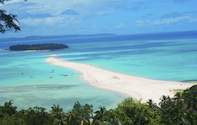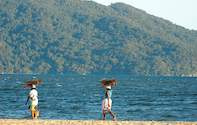
Situated off the southeast coast of Africa, Madagascar is the fourth largest island in the world. It is separated from the coast of Africa by the Mozambique Channel, the shortest distance between the island and the mainland is 400km (248.5 miles).
Madagascar is legendary for its profusion of wildlife and flora, 80% of which is found nowhere else on earth. Isolated from the continents 160 million years ago, Madagascar followed a unique evolutionary path into enormous Tortoises, Elephant birds, and Lemurs.
The animals of Madagascar found plentiful foodstuffs, and an almost total lack of predators. Because evolutionary pressures on Madagascar's early inhabitants were almost nonexistent, the island literally teems with life forms that have changed little in hundreds of thousands, even millions of years. In many ways, Madagascar is literally a land that time forgot.
Lemurs were the highest primate form on the island until the Malagasy people, of Afro-Polynesian ancestry, arrived a mere 2000 years ago. Some of the worlds most unusual birds are found only on Madagascar, gorgeous ground-rollers, the diverse Vanga family, the Couas. Birders will be rewarded by a visit to any of Madagascars splendid reserves. If you long to tick off most of the endemics, including Oxylabes, Newtonias and the rare Madagascar Fish Eagle, we recommend a two-week specialist birding tour.
Madagascar Places of Interest

Andringitra National Park, located in south-east Madagascar, was inaugurated in October 1999. The areas great tourism potential resides specifically in the possibilities it offers for panoramic views, environmental education and sport like trekking. The 31,160-hectare national park lies between two older protected areas, Ranomafana and Isalo National Parks.
As a natural area, Andringitra National Park is in a class of its own, characterized by a very high diversity in plant and animal life and a large variety of endemic species. Andringitra exhibits tropical moist forests, dense montane forests and high mountain prairies crowned by massive granite escarpments. Peak Boby, 2,658 metres (8720.4 feet) above sea level, the highest accessible peak in Madagascar, is the Malagasy second highest mountain and one of the areas principal attractions.
The alpine meadows of the Andohariana plateau are the only natural mountain prairies in Madagascar. Over 30 different species of terrestrial orchids can be seen there every year, between the months of January and March. Besides, nearly half of the non-flying mammal species existing in Madagascar can be found in Andringitra, including 14 species of Lemur.
One particular species, the Golden Bamboo Lemur (Hapalemur aureus) was discovered only in 1996 in neighbouring Ranomafana National Park, in very few numbers. In Andringitra, however, this species, which feeds on a particular type of bamboo known for its cyanide content with no ill effects whatsoever, has an extensive presence.
Geography and Climate

Madagascar is an island located in the Indian Ocean, off the east coast of Africa. It is bound by the Mozambique Channel to the west and the Indian Ocean to the south, north and east. Madagascar consists mainly of a block of crystalline rocks. It is generally described as a plateau, rising sharply from the narrow plain of the east coast and descending in a series of steps to the strip of sedimentary rocks along the west coast.
The high plateau is much indented and, on the eastern edge, cut by deep gorges and waterfalls. There are numerous volcanic outcrops that produce heights over 6,000 ft (the highest point being Tsaratanan, at 9,450 ft) and two former volcanic areas, Ankaratra and Andringingtra, which are over 8,500ft.
The eastern coast is almost straight and has very few anchorages. Behind its coral beaches, there is an almost continuous line of lagoons from Foulpointe to Farafrandana. These are linked by man-made channels to form an inland waterway called the Pangalanes Canal. The island's major rivers flow westward. There are also around nineteen lakes on the island.
Madagascar has three main climactic / floristic zones - the eastern rainforests, the western tropical dry deciduous woods and the semi-arid south - with an unsurpassed diversity of plant species. We can arrange tours for the orchid enthusiast, who will be drawn by the 1200 varieties found in the rainforests, and special botanical and natural history tours.
Madagascar has a tropical maritime climate that is influenced by altitude, the monsoons, and its proximity to the sea. In general, the highlands have a temperate climate with warm rainy weather from November to April and cooler temperatures from May to October. The average annual precipitation varies from 39 to 59 inches.
The coastal region has a tropical climate with no completely dry season. The heaviest rainfall occurs on the coastal region between May and September with average annual precipitation varying from 80 to 120 inches. Average temperature ranges in Antananarivo are from 9 to 20 degrees Celsius (48 to 68 degrees Fahrenheit) in July to 16 to 27 degrees Celsius (61 to 81 degrees Fahrenheit) in December.

 This Madagascar travel guide will highlight the best Madagascar attractions including what to do in Antananrivo and Northhern Madagascar...
This Madagascar travel guide will highlight the best Madagascar attractions including what to do in Antananrivo and Northhern Madagascar... Madagascar Beach Resorts and Hotels offer a comfortable base from which to explore this exotic island of Africa....
Madagascar Beach Resorts and Hotels offer a comfortable base from which to explore this exotic island of Africa....